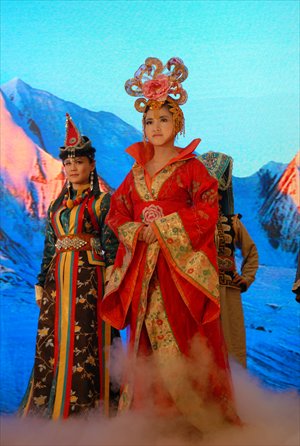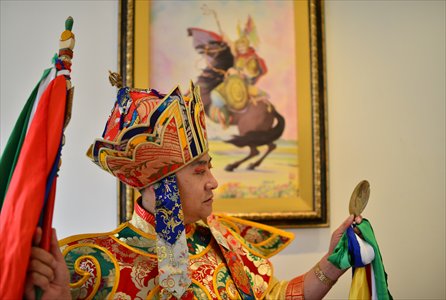
Models wear costumes made according to Tshe-sgrub Tulku's description of King Gesar's princesses.

Tshe-sgrub Tulku gazes into a mirror as he unfolds the epic of King Gesar. Photos: Courtesy of Ma Zhiying, apprentice to Tshe-sgrub Tulku.
Longest oral epic told in mysterious ways
Among Tibetan's various cultural elements that are mysterious to outsiders, the King Gesar epic is certainly one of the most outstanding. Hailed as the longest heroic epic in the world, it has circulated in diverse ways for thousands of years.
Besides the Tibetan region, the King Gesar stories are also popular today among ethnic minorities in China including the Mongolian, Tu, Sugu and Naxi peoples. And even among neighboring countries including Mongolia, India, Bhutan and Nepal, the epic has long been well-known.
As the magical hero in the mind of Tibetans, King Gesar is said to have been born in the current Ashul Grassland in Dege county, Ganzi Prefecture, Sichuan Province around the 11th century when Tibetans were in deep misery brought by tribal wars. King Gesar fought against enemies and evils to finally bring peace and unification to the region.
Out of deep love and respect for him, Tibetans chanted praise for King Gesar for centuries from generation to generation, hence the epic King Gesar stories have been compiled and circulated until today.
Now with the legendary figure becoming a symbol of Tibetan culture, the various ways of unfolding the epic story are also being brought to a wider audience, and they are no less interesting and mysterious than the epic itself.
On the 23rd of last month, a series of King Gesar-related Tangkha paintings were exhibited in Beijing. The Tangkha were drawn in accordance with Gesar rapper Tshe-sgrub Tulku's description of King Gesar's story. At the exhibition, he performed the "Yuanguang Gesar," the most mysterious of the five ways of telling the King Gesar story. Many of the attendees were witnessing it for the first time.
Told in diverse ways
Unlike other famous oral traditions like Homeric epics or Indian epics including the Mahabharata and the Ramayana, the circulation of King Gesar relies on methods other than talking and singing. In fact, there are five main types of Tibetan rappers of the King Gesar epic.
The easily understood traditional forms have names that translate to "hear and learn" and "sing in accordance with those on paper." But there are also some mysterious and inexplicable types such as "by divine visions," "by observing strict rituals to locate and tap into related artifacts," and "by observing circular light in mirror (or Yuanguang Gesar)."
In September 2009, Gesar was placed upon the intangible cultural heritage list of UNESCO, arousing curiosity and interest in studying the epic and its related culture.
"There are around 100 total talking rappers of King Gesar in Tibet now," said Norbu Wangdan, head of the national Gesar office of the Chinese Academy of Social Sciences. He said among those 100 rappers, Tshe-sgrub Tulku is the most notable.
Circular light in mirror
"We have studied Tshe-sgrub Tulku and his 'Yuanguang Gesar' for seven years, and with tens of thousands of video and written documents, we are trying to offer some scientific explanation for the way he tells the King Gesar epic," said Norbu Wangdan.He is now the only one that can perform "Yuanguang Gesar," and meanwhile he is a living Buddha.
"Yuanguang Gesar" is performed by observing the circular light in a mirror (or other instruments like clean water or a lake surface), and being able to see Gesar's life in it, then to sing or talk the story out. When Tshe-sgrub Tulku performed it, he held a small bronze mirror in his hand then started to sing. "He can see what King Gesar is doing, what he is wearing and what weapons he is carrying," said Norbu Wangdan. "His eyes are very different from common people, they can see things that common people can't see. It's like sometimes animals see something that human eyes' are incapable of," Norbu added.
The requirements for practitioners to observe "circular light in mirror" are quite high. Before one begins observing and singing, a series of rites (including applying relevant divine substances and reading secret incantations) must be carried out to make sure he can obtain the ability (conferred with divine power) for observing the "circular light in mirror."
For a formal and complete ritual to perform "Yuanguang Gesar," dozens of instruments are required including an altar, Tibetan incense, water utensil, colorful arrow, butter lamp, blanket, white rice and other grains. Meanwhile, a girl aged 16 who is of noble character, high prestige and without a secular life shall erect the colorful arrow at the ritual.
Spreading Tibetan culture
Now with the epic being increasingly pursued and promoted by its practitioners, people are not just getting to know the story of King Gesar, but are able to appreciate other items that help unravel the mystery of Tibetan culture.
Besides Tangkha, which has become the most popular way of depicting King Gesar's life and story, other products like costumes, weapons and musical instruments are also meeting the public. For example, at the exhibition, dozens of costumes made according to Tshe-sgrub Tulku's description of King Gesar's princesses were worn by models on stage.
Among the overall Chinese cultural elements, Tibetan culture has its own very distinguished characteristics. And the epic is the pearl of its cultural crown. In 2009, Tibetan writer A Lai published his book King Gesar, underscoring the significance of this live epic in local people's life.
"From King Gesar, people can feel changes in the herdsmen's life in Tibet," he said. "In Han culture, written literature such as poems by Li Bai or Su Dongpo are preferred, but in Tibetan culture, oral literature like the epic story takes great importance."
"It's not just that the epic story should be known to more people, but those rappers who have maintained cultural continuity, their performances and their images should also be displayed to people."
By Lu Qianwen
